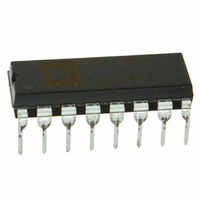AD421BNZ Analog Devices Inc, AD421BNZ Datasheet - Page 10

AD421BNZ
Manufacturer Part Number
AD421BNZ
Description
IC DAC SNGL 16BIT 16-DIP
Manufacturer
Analog Devices Inc
Datasheet
1.AD421BRZRL.pdf
(14 pages)
Specifications of AD421BNZ
Data Interface
Serial
Settling Time
8µs
Number Of Bits
16
Number Of Converters
1
Voltage Supply Source
Single Supply
Power Dissipation (max)
1.95mW
Operating Temperature
-40°C ~ 85°C
Mounting Type
Through Hole
Package / Case
16-DIP (0.300", 7.62mm)
Resolution (bits)
16bit
Sampling Rate
125SPS
Input Channel Type
Serial
Supply Current
575µA
Digital Ic Case Style
DIP
No. Of Pins
16
Lead Free Status / RoHS Status
Lead free / RoHS Compliant
Available stocks
Company
Part Number
Manufacturer
Quantity
Price
Part Number:
AD421BNZ
Manufacturer:
ADI/亚德诺
Quantity:
20 000
A capacitor of 0.01 µF connected between COMP and DRIVE
is required to stabilize the feedback loop formed with the
regulator op amp and the external pass transistor. An external
snubber circuit of 1 kΩ and 1000 pF is required between the
DRIVE pin and COM and a 0.1 µF cap between COMP and
DRIVE to stabilize the feedback loop formed by the regulator
op amp and the external pass transistor.
The internal 2.5 V reference on the AD421 is used as the refer-
ence for the AD421 and this has to be decoupled with a 4.7 µF
capacitor for compensation and stability purposes. The sigma-
delta DAC on the part consists of a second order modulator
followed by a continuous time filter. The resistors for each of
the filter sections are on-chip while the capacitors are external
on the C1 to C3 pins. To meet the specified full-scale settling
on the part, low dielectric absorption capacitors (NPO) are
required. Suitable values for these capacitors are C1 = C2 =
0.01 µF, and C3 = 0.0033 µF.
The digital interface on the AD421 consists of just three wires:
DATA, CLOCK and LATCH. The interface connects directly
to the serial ports of commonly-used microcontrollers without
the need for any external glue logic. Data is loaded into an input
shift register on the rising edge of the CLOCK signal and is
transferred to the DAC latch on the rising edge of the LATCH
signal.
Reduce Power Load on External FET
Figure 12 shows a circuit where an external NPN transistor is
added to reduce the power loading on the FET. The FET will
supply the V
sistor can carry the BOOST current. The BOOST pin sinks the
necessary current from the loop so that the current flowing into
BOOST plus the current flowing into COM is equal to the
programmed loop current. The external NPN transistor reduces
the external power load that the FET has to carry to less than
750 µA if no other components share the V
than 4 mA in applications that share the same V
AD421.
Figure 12. External NPN Transistor Reduces Power Load
on FET
AD421
V
CC
CIRCUITRY
AD421
TO EXTERNAL
REFERENCE
80k
BANDGAP
2.2 F
COM
CC
LV
112.5k
and an external high voltage NPN bipolar tran-
1.21V
134k
40
V
121k
75k
CC
DN25D
DRIVE
COMP 0.01 F
BOOST
LOOP RTN
CC
line and to less
1k
1000pF
CC
line as the
BC639/BC337
LOOP(+)
LOOP(–)
–10–
Smart Transmitter
The AD421 is intended for use in 4 mA to 20 mA smart trans-
mitters. A smart transmitter is a system that incorporates a
microprocessor system which is used for linearization and
communication. Figure 13 shows a block diagram of a typical
smart transmitter. In this example, the transmitter does not have
any digital communication capabilities.
Figure 14 shows a typical smart transmitter application circuit
using the AD421.
The sensor voltage to be measured at the transmitter is con-
verted using a high resolution sigma-delta converter such as
the AD7714 or AD7715. These devices have an on-board PGA
which can provide gains on the analog front end from 1 to 128.
This allows for an analog input range as low as 10 mV which
allows the transducer to be connected directly to the ADC. The
AD7714/AD7715 have digital calibration techniques which are
used to eliminate gain and offset errors. In addition, back-
ground calibration techniques are provided whereby the part
continually calibrates itself and the user does not have to
worry about issuing periodic calibration commands to remove
effects of time and temperature drift.
In normal operation the microprocessor reads the data from the
AD7714/AD7715. After the data is processed by the micro-
controller, the data is transferred from the serial port of the
processor to the AD421 for transmission over the 4 to 20 mA
loop back to the control center.
The AD421 regulates the loop voltage to create power for the
rest of the transmitter circuitry. In Figure 14, the derived V
voltage is 3.3 V which is achieved by connecting the LV pin to
V
age for the AD421 itself while REF OUT1 provides the refer-
ence voltage for the AD7714/AD7715.
CC
SENSORS
through 0.01 µF. REF OUT2 provides the reference volt-
Figure 13. Typical Smart Transmitter
CONVERTER
A/D
PROCESSOR
MEMORY
MICRO-
CONVERTER
D/A
4mA TO 20mA
MEASUREMENT
CIRCUIT
REV. C
CC













